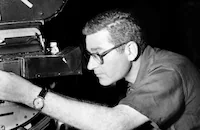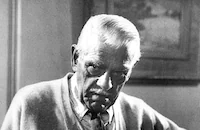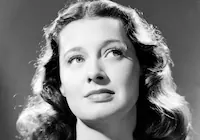I don't want to sound like a bossy second-grade teacher, but you really
are
going to have to get
The Val Lewton Horror Collection.
It's hardly a perfect collection, especially with all the audio commentaries by
film historians who wallow in minutia that gets very tiring very quickly. But these
facts are clear: (1) Lewton produced some of the best B-movies ever turned out on
low budgets and quickie schedules for a Hollywood studio; and, (2) Some of the
set's most noteworthy content is on the two discs available
only within the
five-disc boxed set.
First, some background. Struggling RKO hired Russian immigrant Lewton, then a story
editor at David O. Selznick's studio, to head up a unit that would make low-budget
horror movies and challenge Universal's dominance in that genre. RKO would have
been happy to release monster movies like Universal's, and the studio imposed
monstrous-sounding titles on Lewton's movies before scripts were ever penned. But
the resultant stories were much more ambitious than that. Instead of using
monsters, Lewton's subtle use of the power of suggestion left much of the terror to
the viewer's imagination. By withholding shots of the source of terror in favor of
foreboding shadows and sounds, and offering stories that usually took place in a
contemporary, realistic setting, Lewton forged a distinctive mix in his RKO
chillers. (Though he rarely took a writing credit, and never under his own name,
Lewton wrote the final screenplay drafts for his RKO movies.)
Lewton's 1942-46 RKO chillers fall into three groups: the first trio of movies
(
Cat People,
I Walked with a Zombie,
The Leopard Man), all
directed by Jacques Tourneur; after RKO split up Lewton and Tourneur to spread
their talents wider, a mid-section of Lewton movies that often stuck to the style
of the Tourneur pictures (
The Seventh Victim,
The Ghost Ship,
The
Curse of the Cat People); and, after the so-so financial performance of the
straight dramas
Mademoiselle Fifi and
Youth Runs Wild, the three
Lewton productions starring Boris Karloff (
Isle of the Dead,
The Body
Snatcher and
Bedlam).
Because the DVDs include two movies (each averages about only 72 minutes in
length), the set often mixes titles from these periods on them:
Cat People and
The Curse of the Cat People:
Cat People,
released in late 1942, is undoubtedly the most important Lewton movie, and this
disc is the best place for the uninitiated to start. It set the tone for the rest
of his RKO movies and, very importantly, was a big hit. Though the producer was
forever stuck with imposed titles and tight budgets, its success gave Lewton a
measure of creative control over his stories.
In its tale of the ill-fated marriage between a Serbian immigrant (Simone Simon)
and a boat designer (Kent Smith),
Cat People blends naturalistic staging and
supernatural story as Lewton so often would. Irena, Simon's title character,
believes she's descended from a line of women who turn into vengeful felines when
sexually or emotionally aroused, so she won't consummate the marriage, which cranks
up the sexual tension to levels unheard of in 1940s Hollywood movies, especially
when Smith's character turns to the chummy co-worker who loves him (Jane Randolph)
for advice. The movie's archetypal moments come when Irena stalks her rival through
Central Park, and the extended silence becomes broken by a braking bus that lunges
into the picture (a trademark Lewton device he'd often repeat) and when the
still-stalked rival gets spooked by shadows and noises as she swims alone in a
pool. Paul Schrader remade
Cat People in 1982, but the original is the
better version.
The Curse of the Cat People, out in 1944, is indicative of how Lewton
subverted his RKO bosses' orders. Told to make a
Cat People sequel,
Curse is instead a very involving, very sensitive portrait of a lonely
child. With the Smith and Randolph characters now married, following the death of
Irena in the first film, their biggest worry is their daydreaming young daughter
Amy (Ann Carter), who sees a picture of Irena and conjures up her image as an
imaginary friend. Though lacking the visual lyricism of its predecessor, it's one of
Lewton's best. Robert Wise co-directed with Gunther V. Fritsch, the first taking
over for the second, who RKO fired for finishing only half the movie during the
allotted schedule.
I Walked with a Zombie and
The Body Snatcher: Another great double
feature. The first, made just after
Cat People, is more evidence of
Tourneur's talent as a visual storyteller. A variation on
Jane Eyre
transposed to the West Indies, it finds a Canadian nurse (Frances Dee) arriving to
her new post in the Caribbean, only to discover her new patient is a catatonic
woman once caught in a love triangle between her husband (Tom Conway) and his
half-brother (James Ellison), and that the island's native culture is steeped in
voodoo. Like
Cat People, an eerie chiller that travels far beyond the shocks
we associate with horror. Meanwhile,
The Body Snatcher is the best of
Lewton's three pictures with Karloff (it was the second). Inspired by the
Burke-Hare grave-robbing scandal, it's set in 1831 Edinburgh, with its main
conflict pitting two former cadaver-stealing allies: a cabman (Karloff) who still
digs up graves and a doctor (Henry Daniell) who's graduated to respectability and
now only
hires people to rob graves.
The Body Snatcher, directed by
Wise, is a fine example of how Lewton's movies not only avoided monsters, they also
avoided outright villains and skillfully mined the moral grey zone.
Isle of the Dead and
Bedlam: The first and third Lewton-Karloff
collaborations, both also period pieces, are indicative of how Lewton's later RKO
movies could be well-crafted, yet not as interesting as intended. The first, about
a group of people quarantined on a Greek island during a plague scare, and the
second, centered on London's notorious insane asylum of the 18th century, used
period paintings and drawing as visual inspiration, so maybe it's not surprising
they feel static. They're not bad and they give Karloff roles superior to his usual
characters, but they feel flat compared to Lewton's more evocative work.
The Leopard Man and
The Ghost Ship: the first of the two discs
available only within the set offers two fine movies. The first is Tourneur's
rendering of Cornell Woolrich's novel,
Black Alibi, about what happens when
a deadly black leopard gets loose in a New Mexico town. It's surely more uneven
than Tourneur's two previous Lewton movies, yet it has great set pieces, especially
when the cat stalks a teen who's been sent to the store by her mother.
The Ghost
Ship has been one of the most elusive Lewton movies, as it was pulled from
release by RKO after a writer filed a plagiarism lawsuit, claiming the movie took
elements from a script he had submitted to Lewton's office. Although Lewton never
saw that script, RKO lost the case and pulled the movie. As with
Curse of the
Cat People, made just after it,
Ghost Ship comes up with something much
better than the mere horror film RKO wanted. Its conflict between the idealistic
new third officer (Russell Wade) and the power-mad captain (Richard Dix) on a
freighter doesn't just recall
The Caine Mutiny, which Herman Wouk hadn't
written yet, it also turns into an exploration of authority run amok, an
anti-Fascist parable for its wartime audience.
The Seventh Victimand
Shadows in the Dark: The Val Lewton Legacy: the
second of the boxed-set-only discs contains two essentials.
The Seventh
Victim,, the first non-Tourneur Lewton movie, directed by Mark Robson in
keeping with Tourneur's style, may be the eeriest of the producer's movies. Kim
Hunter makes her film debut as a teen who travels to New York City to look for her
missing older sister (Jean Brooks), and discovers that her sister became involved
with a devil-worshipping cult that now wants her dead. If Lewton's movies stew in
the juices of death, grief and loneliness,
The Seventh Victim may be his
grimmest. It's also his most noir movie, with all of its dangers stemming from
human loneliness. A beautiful piece of melancholy.
Running a little under an hour,
Shadows in the Dark is literally littered
with interview subjects. Do we really need five film historians, four writers and
seven directors praising Lewton? An indication of how cluttered it is comes
when George A. Romero who, like Lewton, knows a thing or two about movie zombies,
is never heard offering his take on Lewton's kind of voodoo-based zombie, much
different from Romero's Pittsburgh zombies. Still, this is a good overview of the
producer's life and work, and it's hard to argue with any of the praise heaped upon
Lewton's movies. They deserve it. Full of family snapshots and home movie footage,
as well as the comments of Lewton's son, Val E. Lewton,
Shadows of the Dark
offers a strong sense of how Lewton's RKO movies reflected his personality: dark,
literate, competent.
Most of those film historians in the documentary handle audio commentaries on the
set's movies, though there's no commentary for
The Ghost Ship, which
seemingly has the most interesting "back story." The most worthwhile commentary is
definitely the late Robert Wise's, on
. It's apparently
culled from one long interview with the director, with the interviewer edited out,
and it covers all of his movies with Lewton (the others being The Curse of the
Cat People and Mademoiselle Fifi).
Wise's first-hand anecdotes are much more interesting than the historians'
micro-observations and rabid research, which is often along the lines of "This
scene was filmed on October 13, but this insert within it was filmed on November
4." Sorry, stuff like that is just not that interesting. The historians are
all well-prepared and speak well, but when I cautiously popped in director William
Friedkin's commentary for The Leopard Man—cautiously because Friedkin's
The Narrow Margin commentary had some dubious observations — it was really
refreshing to hear him say, "Frankly, the movie speaks for itself" in the first
minute. Greg Mank's commentaries on Cat People and The Curse of the Cat
People also include snippets of his phone interview with the late Simone Simon.
For some reason, though, these snippets are often semi-arbitrarily dropped in with
no set-up and, like most of the historians commenting, Mank doesn't even open by
telling us his qualifications to do a commentary for a Val Lewton movie. When that
happens, I just want to ask, "Dude, where's your credibility?"
For more information about The Val Lewton Horror Collection, visit Warner Video. To order The Val Lewton Collection, go to
TCM Shopping.
by Paul Sherman





























